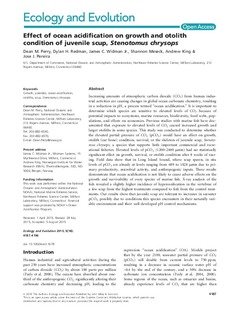| dc.description.abstract | Increasing amounts of atmospheric carbon dioxide (CO2) from human industrial activities are causing changes in global ocean carbonate chemistry, resulting in a reduction in pH, a process termed “ocean acidification.” It is important to determine which species are sensitive to elevated levels of CO2 because of potential impacts to ecosystems, marine resources, biodiversity, food webs, populations, and effects on economies. Previous studies with marine fish have documented that exposure to elevated levels of CO2 caused increased growth and larger otoliths in some species. This study was conducted to determine whether the elevated partial pressure of CO2 (pCO2) would have an effect on growth, otolith (ear bone) condition, survival, or the skeleton of juvenile scup, Stenotomus chrysops, a species that supports both important commercial and recreational fisheries. Elevated levels of pCO2 (1200–2600 latm) had no statistically significant effect on growth, survival, or otolith condition after 8 weeks of rearing. Field data show that in Long Island Sound, where scup spawn, in situ levels of pCO2 are already at levels ranging from 689 to 1828 latm due to primary productivity, microbial activity, and anthropogenic inputs. These results demonstrate that ocean acidification is not likely to cause adverse effects on the growth and survivability of every species of marine fish. X-ray analysis of the fish revealed a slightly higher incidence of hyperossification in the vertebrae of a few scup from the highest treatments compared to fish from the control treatments. Our results show that juvenile scup are tolerant to increases in seawater pCO2, possibly due to conditions this species encounters in their naturally variable environment and their well-developed pH control mechanisms. | nb_NO |

